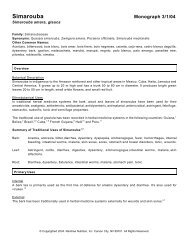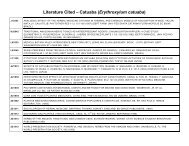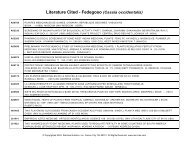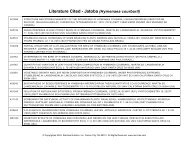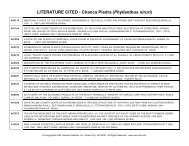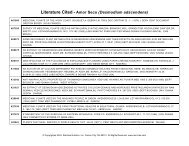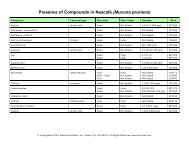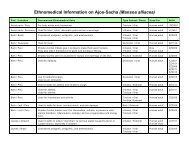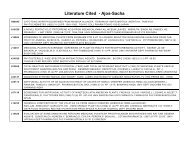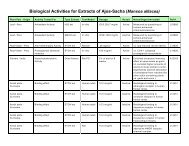Organ Specific Guide - Raintree Nutrition, Inc
Organ Specific Guide - Raintree Nutrition, Inc
Organ Specific Guide - Raintree Nutrition, Inc
You also want an ePaper? Increase the reach of your titles
YUMPU automatically turns print PDFs into web optimized ePapers that Google loves.
GUACATONGA CAPSULES<br />
Description: Some of the active ingredients documented, researched, and verified in guacatonga are a<br />
group of clerodane diterpenes. These phytochemicals are being researched and patented for their active<br />
biological properties and potential uses, including as a natural antacid.<br />
Traditional uses by organ or system: Digestion/Elimination: As a natural antacid and for stomach<br />
disorders (ulcers, acid reflux, indigestion, dyspepsia, stomachache).<br />
Ingredients: Pure 100% guacatonga leaves (Casearia sylvestris).<br />
Suggested Use: Take 3 capsules 2-3 times daily.<br />
Contraindications: Not to be used during pregnancy or while breast-feeding.<br />
Drug Interactions: None reported.<br />
Other Practitioner Observations and Possible Precautions: None reported.<br />
Synopsis of research: (Please the online Tropical Plant Database for Guacatonga for all cited<br />
research.)<br />
Guacatonga has a long history of use in Brazilian herbal medicine, documented in early folk medicine<br />
books as an antiseptic and wound healer for skin diseases (in 1939), as a topical analgesic (in 1941), and<br />
as an anti-ulcer drug (in 1958). It is currently used in Brazilian herbal medicine systems as a blood purifier,<br />
anti-inflammatory, and antiviral to treat rheumatism, syphilis, herpes, stomach and skin ulcers, edema,<br />
fevers of all kinds, diarrhea, and as a topical analgesic.<br />
Most of the research on the chemicals and activities of guacatonga has been performed by Brazilian<br />
research groups over the years. The first published toxicity study with rats indicated no toxicity with an<br />
ethanol extract of the leaves at 1840 mg per kg. This research group, at the University of Sao Paulo,<br />
studied the antiulcer properties of the plant (based on its long history of use as an effective herbal remedy<br />
for ulcers). They published two studies confirming these benefits. The first study, with rats (in 1990),<br />
showed that a crude leaf extract reduced the volume of gastric secretion by 42%, but had little effect on pH.<br />
The extract also prevented lab-induced acute gastric mucosal injury which was equivalent to the antiulcer<br />
drug cimetidine (Tagamet®). Ten years later they published a second rat study, documenting that a crude<br />
leaf extract protected the stomach lining without changing gastric pH and sped healing of acetic acidinduced<br />
chronic ulcers and H. pylori ulcers.<br />
Another Brazilian researcher documented that a bark-and-leaf infusion demonstrated analgesic and mild<br />
anti-inflammatory properties in mice. A university researcher followed up on the anti-inflammatory research,<br />
publishing in her dissertation that an extract of the leaves was as effective against inflammation in mice as<br />
the NSAID drugs Prioxicam® and Meloxicam®. Leaf extracts have also been shown by two research groups<br />
to be active against common food-poisoning bacteria strains, Bacillus cerus and B. subtilis, but inactive<br />
against such other common bacteria as Staphylococcus, Streptoccoccus, and E. coli.<br />
The chemical makeup of guacatonga is quite complex. Scientists discovered that the leaves and twigs<br />
of the plant contain a phytochemical called lapachol. This is the well known and studied anticancerous and<br />
antifungal compound from which another rainforest plant, pau d'arco (Tabebuia impetiginosa), gained much<br />
renown. While other researchers have been studying the anticancerous and antitumorous properties of<br />
guacatonga, a completely different set of phytochemicals has fueled their interest. These compounds,<br />
called clerodane diterpenes, are found abundantly in guacatonga and some have been patented as<br />
antisarcomic agents. Clerodane diterpenes have been documented with a wide range of biological activities<br />
ranging from insect antifeedants, to antitumorous, anticancerous, and antibiotic agents, to HIV replication<br />
inhibitors. Some of the clerodane diterpenes documented in guacatonga are novel chemicals which<br />
scientists have named casearins (A thru S). Other chemicals in guacatonga include caprionic acid, casearia<br />
clerodane I thru VI, casearvestrin A thru C, hesperitin, lapachol, and vicenin.



